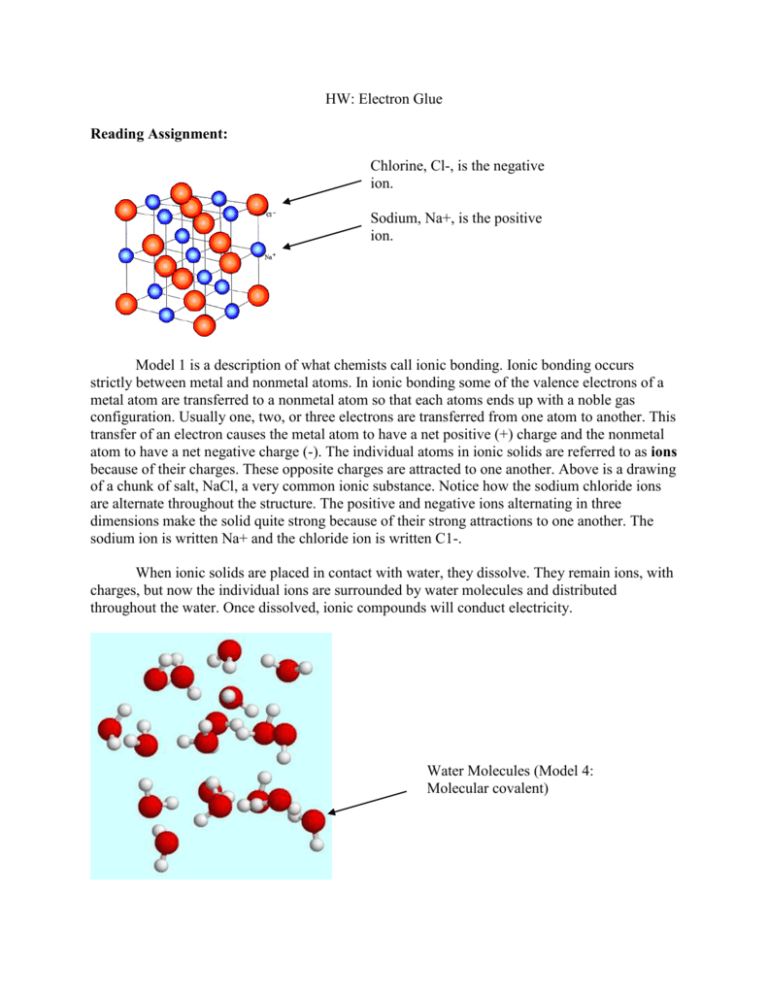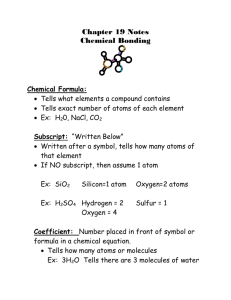HW: Electron Glue
advertisement

HW: Electron Glue Reading Assignment: Chlorine, Cl-, is the negative ion. Sodium, Na+, is the positive ion. Model 1 is a description of what chemists call ionic bonding. Ionic bonding occurs strictly between metal and nonmetal atoms. In ionic bonding some of the valence electrons of a metal atom are transferred to a nonmetal atom so that each atoms ends up with a noble gas configuration. Usually one, two, or three electrons are transferred from one atom to another. This transfer of an electron causes the metal atom to have a net positive (+) charge and the nonmetal atom to have a net negative charge (-). The individual atoms in ionic solids are referred to as ions because of their charges. These opposite charges are attracted to one another. Above is a drawing of a chunk of salt, NaCl, a very common ionic substance. Notice how the sodium chloride ions are alternate throughout the structure. The positive and negative ions alternating in three dimensions make the solid quite strong because of their strong attractions to one another. The sodium ion is written Na+ and the chloride ion is written C1-. When ionic solids are placed in contact with water, they dissolve. They remain ions, with charges, but now the individual ions are surrounded by water molecules and distributed throughout the water. Once dissolved, ionic compounds will conduct electricity. Water Molecules (Model 4: Molecular covalent) Models 2and 4 both represent bonding that is referred to by chemists as covalent bonding. The valence electrons are shared between atoms, such that the electrons are attracted to two nuclei. In Model 4, the bonding is called molecular covalent. This means that the atoms are connected into small units, called molecules, by covalent bonds. However, the molecules themselves are not connected by covalent bonds to one another. Thus, molecular covalent substances consist of a large group of individual molecules. The picture shows an artist’s idea of a small collection of water molecules. Note that whenever we are talking about molecules in chemistry, we are referring to covalently bonded groups of atoms. Molecular covalent substances tend to be liquids, gases or soft solids. This is because the individual molecules have more freedom to move within the substance. This is a part of a diamond which is carbon atoms in extended covalent bonding (model 2). Model 2 represents a very specific type of covalent bonding called extended covalent bonding. This means that there is a covalent connection between each atom and all of the adjacent atoms that surround it. This extended covalent bonding creates a very strong substance that is not easily broken apart. Diamond and silicon are examples of substances that have extended covalent bonding. Diamond is made entirely of carbon atoms. If we looked at a chunk of diamond on a particulate level, we’d see that each carbon atom is bonded in three dimensions to the carbon atoms surrounding it. The illustration shows an artist’s rendering of a piece of diamond from an atomic level. The share electrons have been replaced by sticks showing the connection between all the atoms. Silicon dioxide, sand (SiO2), is another extended covalent substance. You may have chosen to put in the molecular covalent category because it is made of two nonmetal atoms. Nevertheless, it is a very hard solid, unlike, the molecular covalent compounds. Its hardness comes from an extended network of covalent bonds throughout the material. This is a piece of silver, Ag, with a “sea” of electrons. Model 3 is referred to as metallic bonding. In the case of metallic bonding each atom contributes electrons to the solid. Thus, each atom becomes essentially positive in charge, having lost some electrons. The electrons then form a sort of sea of electrons around the atoms. The atoms in turn are attracted to the negatively charged “sea”. The picture above is an artist’s rendering of a block of silver, Ag, atoms. The “sea of electrons” is visible around the silver atoms. Answer the following questions: 1. Read the passage above and write a brief summary of the four types of chemical bonds. 2. You observe NO2(g) when you dissolved Cu(s) in nitric acid in the copper cycle lab. How would you classify the bonding in NO2 (g)? Explain. 3. Think about the physical properties of the following substances, and decided which type of bonding you would probably find in each substance. Explain your reasoning. A) hair gel B) silver bracelet C) motor oil D) sodium bicarbonate (baking soda) 4. Look at the chemical makeup of the following substances and decide which type of bonding you would probably find in each substance. A) Zn(s) zinc B) C3H8(1) propane C) CaCO3(s) calcium carbonate







